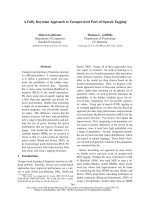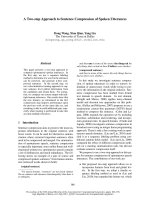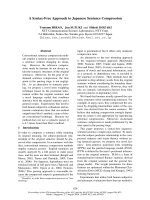Báo cáo sinh học: "A marginal quasi-likelihood approach to the analysis of Poisson variables with generalized linear mixed models" pot
Bạn đang xem bản rút gọn của tài liệu. Xem và tải ngay bản đầy đủ của tài liệu tại đây (356.3 KB, 7 trang )
Note
A
marginal
quasi-likelihood
approach
to
the
analysis
of
Poisson
variables
with
generalized
linear
mixed
models
JL
Foulley
S Im
1
INRA,
Institut
National
de
la
Recherche
Agronomique,
Station de
Genetique
Quantitative
et
Appliquee,
78352
Jouy-en-Josas
Cedex;
2
INRA,
Station
de
Biométrie
et
d’Intelligence
Artificielle,
31326
Castanet
Tolosan
Cedex,
France
(Received
19
June
1992;
accepted
16
November
1992)
Summary -
This
paper
extends
to
Poisson
variables
the
approach
of
Gilmour,
Anderson
and
Rae
(1985)
for
estimating
fixed
effects
by
maximum
quasi-likelihood
in
the
analysis
of
threshold
discrete
data with
a
generalized
linear
mixed
model.
discrete
variable
/
Poisson
distribution
/
generalized
linear
mixed
model
/
quasi-
likelihood
Résumé -
Une
approche
de
quasi-vraisemblance
pour
l’analyse
de
variables
de
Poisson
en
modèle
linéaire
mixte
généralisé.
Cet
article
généralise
à
des
variables
de
Poisson
l’approche
de
Gilmour,
Anderson
et
Rae
(1985!
destinée
à
l’estimation
par
maximum
de
quasi-vraisemblance
des
ef,!’ets
fi,!és
lors
de
l’analyse
de
variables
discrètes
à
seuils
sous
un
modèle
mixte.
variables
discrètes
/
distribution
de
Poisson
/
modèle
linéaire
mixte
généralisé
INTRODUCTION
As
shown
by
Ducrocq
(1990),
there
has
been
recently
some
interest
in
non
linear
statistical
procedures
of
genetic
evaluation.
Examples
of
such
modelling
procedures
involve:
1)
the
threshold
liability
model
for
categorical
data
(Gianola
and
Foulley,
1983;
Harville
and
Mee,
1984)
and
for
ranking
data
in
competitions
(Tavernier,
*
Correspondence
and
reprints
1991);
2)
Cox’s
proportional
hazard
model
for
survival
data
(Ducrocq
et
al,
1988);
and
3)
a
Poisson
model
for
reproductive
traits
(Foulley
et
al’,
1987).
In
FGI,
estimation
of
fixed
(II)
and
random
(u)
effects
involved
in
the
model
is
based
on
the
mode
of
the
joint
posterior
distribution
of
those
parameters.
As
discussed
by
Foulley
and
Manfredi
(1991),
this
procedure
is
likely
to
have
some
drawbacks
regarding
estimation
of
fixed
effects
due
to
the
lack
of
integration
of
random
effects.
A
popular
alternative
is
the
quasi-likelihood
approach
(Mc
Cullagh
and
Nelder,
1989)
for
generalized
linear
models
(GLM)
which
only
requires
the
specification
of
the
mean
and
variance
of
the
distribution
of
data.
This
procedure
has
been
used
extensively
by
Gilmour
et
al
b
(1985)
in
genetic
evaluation
for
threshold
traits.
In
particular,
GAR
derived
a
very
appealing
algorithm
for
computing
estimates
of
fixed
effects
which
resembles
the
so-called
mixed
model
equations
of
Henderson
(1984).
The
purpose
of
this
note
is
to
show
how
the
GAR
procedure
can
be
extended
to
Poisson
variables.
THEORY
The
same
model
as
in
FGI
is
postulated.
Let
Yk
be
the
random
variable
(with
realized
value
y!
=
0,1,2 )
pertaining
to
the
kth
observation
(k
=
1,2, ,
K).
Given
Ak,
the
Y!s
have
independent
Poisson
distributions
with
parameter
Ak,
ie:
As
the
canonical
link
for
the
Poisson
distribution
is
the
logarithm
(Me
Cullagh
and
Nelder,
1989),
Ak
is
modelled
as:
where p
and
u
are
(p
x 1 )
and
(q
x 1 )
vectors
of
fixed
and
random
effects
respectively,
and
x’
and
z’
are
the
corresponding
row
incidence
vectors,
the
parameterization
in P
being
assumed
to
be
of
full
rank.
Notice
that
[2]
is
an
extension
to
mixed
models
of
the
structure
of
&dquo;linear
predictors&dquo;
originally
restricted
to
fixed
effects
in
the
GLM
theory:
see
eg
Breslow
and
Clayton
(1992)
and
Zeger
et
al
(1988)
for
more
detail
about
the
so-called
general
linear
mixed
models
(GLMM).
Moreover,
it
will
be
assumed
as
in
other
studies
(Hinde,
1982;
Im,
1982;
Foulley
et
al,
1987)
that
u
has
a
multivariate
normal
distribution
N(0,
G)
with
mean
zero
and
variance
covariance
matrix
G,
thus
resulting
in
what
is
called
the
Poisson-lognormal
distribution
(Reid,
1981;
Aitchinson
and
Ho,
1989).
FGI
showed
that
the
mixed model
structure
in
[2]
can
cope
with
most
modelling
situations
arising
in
animal
breeding
such
as,
eg,
sire,
sire
and
maternal
grand
sire,
and
animal
models
on
one
hand,
and
direct
and
maternal
effects
on
the
other
hand.
A
simple
example
of
that
is
the
classical
animal
model
In
(a2! )
=
x!.
p +
ai
+pi,
for
the
jth
performance
of
the
ith
female
(eg
ovulation
rate
of
an
ewe)
as
a
function
of
a
From
now
on
referred
to
as
FGI
(Foulley,
Gianola
and
Im) ;
b
from
now
on
referred
to
as
GAR
(Gilmour,
Anderson
and
Rae).
the
usual
fixed
effects
(eg
herd
x
year,
parity),
the
additive
genetic
value
ai
and
a
permanent
environmental
component
pi
for
female
i.
According
to
the
GLM
theory,
the
quasi-likelihood
estimating
equations
for 13
are
obtained
by
differentiating
the
log
quasi-likelihood
function
Q(j;
y,
G)
(G
being
assumed
known),
with
respect
to
(3,
and
equating
the
corresponding
quasi-score
function
to
zero,
vix.
As
clearly
shown
by
the
expression
in
[3],
the
quasi-likelihood
approach
only
requires
the
specification
of
the
marginal
mean
vector
11
and
of
the
variance
covariance
matrix
V
of
the
vector
Y
of
observations.
Given
the
moment
generating
function
of
the
multivariate
normal
distribution
ie
E(exp
(t’Y)
=
exp
[t’1I
+
(t’Vt/2)j,
it
can
be
shown
that:
(Hinde,
1982;
Zeger
et
al,
1988)
and
(Aitchinson
and
Ho,
1989),
8!l
being
the
Kronecker
delta,
equal
to
1
if k
=
l,
and
0
otherwise.
Generally
models
used
in
animal
breeding
yield,
in
the
absence
of
inbreeding,
homogeneous
variances
so
that
for
any
k,
a2
= zkGz!
=
a2,
and
In (
ILk
)
=
x!!-1-
(a
2
/2).
Moreover,
letting
L!Kxx) _
{exp(z!Gzl) - 1!
and
M
lKx
x)
=
Diag
1,U
kl
,
variances
and
covariances
of
observations
defined
in
[9]
can
be
expressed
in
matrix
notations
as:
Using
Fisher’s
scoring
method
based
on
the
gradient
vector
âQ(.)/âfi,
and
minus
the
expected
value
of
the
Hessian
matrix
-E[,9’Q(.)Iai3alY],
one
gets
an
iterative
algorithm
which
can
be
expressed
under
the
form
of
weighted
least-squares
equations:
[t]
being
the
round
of
iteration.
As
in
GAR,
one
may
consider
to
approximate
V.
This
can
be
accomplished
here
using
a
first
order
Taylor
expansion
of
exp
(z!Gz1)
around
G
=
0,
ie
replace
exp
(z!Gz1) -1
1 in
L,
by
z!Gzl’
This
approximation
is
likely
to
be
realistic
as
long
as
the
u-
part
of
variation
remains
small
enough
in
the
total
variation.
Doing
so,
V
in
[10]
becomes V
=
M
+
MZGZM,
with
Z!Kxql
=
(
Zl
,
z2
, ,
z! , ,
Zk)’
being
the
overal
incidence
matrix
of
u.
Putting
this
formula
into
the
inverse
of
W
in
!12!,
one
has
This
formula
exhibits
the
classical
form
(R
+
ZGZ’
in
the
usual
notation)
of
a
variance
cori_ance
matrix
of
data
described
by
a
linear
mixed
model;
this
allows
us
to
solve
for?
in
[11]
using
the
mixed model
equations
of
Henderson
(Henderson,
1984),
ie
here
with:
or,
alternatively,
defining
The
similarity
between
[16]
and
the
formula
given
by
FGI
should
be
noted.
Actually,
here
tlk
=
Eu (.),k)
replaces
Ak,
thus
indicating
the
way
random
effects
are
integrated
out
in
the
GAR
procedure.
It
should
be
kept
in
mind
that
the
main
advantage
of
[15]
is
to
provide
estimates
ofp
which
can
be
computed
in
a
similar
way
as
with
mixed
model
equations
of
Henderson
(1984).
These
equations
also
imply
as
a
by-product
an
estimate
of
u
which,
as
pointed
out
by
Knuiman
and
Laird
(1990)
about
the
GAR
system
of
equations,
&dquo;has
no
apparent
justification&dquo;.
DISCUSSION
The
procedure
assumes
G
known.
Arguing
from
the
mixed model
structure
of
equations
in
!15J,
GAR
have
proposed
an
intuitive
method
for
estimating
G
which
mimics
classical
EM
type-formulae
for
linear
models.
FGI
advocated
approximate
marginal
likelihood
procedures
based
on
the
ingredients
of
their
iterative
system
in #
and
u.
Actually,
applying
such
procedures
would
mean
to
use
a
third
level
of
approximation;
the
first
one
was
resorted
to
quasi-likelihood
procedures
and
the
second
one
to
the
use
of
!15J
instead
of
!11J.
Alternatively,
pure
maximum
likelihood
approaches
based
on
the
EM
algorithm
were
also
envisaged
by
Hinde
(1982),
viewing
u
as
missing
and
using
Gaussian
quadratures
to
perform
the
numerical
integration
of
the
random
effects.
More
details
about
methods
for
estimating
variance
components
in
such
non-linear
models
can
be
found
eg
in
Ducrocq
(1990),
Knuiman
and
Laird
(1990),
Smith
(1990),
Thompson
(1990),
Breslow
and
Clayton
(1992);
Solomon
and
Cox
(1992)
and
Tempelman
and
Gianola
(1993).
It
must
be
kept
in
mind
that
the
mixed
model
structure
in
[2]
applies
to
a
large
variety
of
situations.
In
particular,
it
can
be
used
to
remove
extra-Poisson
variation
when
the
fit
due
to
identified
explanatory
variables
remains
poor.
In
such
cases,
some
authors
( eg
Hinde,
1982;
Breslow,
1984)
have
suggested
to
improve
the
fit
by
introducing
an
extra
variable
into
the
random
component
part
of
[2]
ie
by
modelling
the
Poisson
mean
as
In
(A
k)
=
xk13
+
z!.u
+
ek.
This
procedure
can
be
applied
eg
to
a
sire
model
so
as
to
fit
the
fraction
(3/4)
of
the
genetic
variance
that
is
not
explicitly
accounted
for
in
the
model.
Finally,
our
approach
can
also
be
used
for
partitioning
the
observed
phenotypic
variance
(Q!)
into
its
genetic
(a9)
and
residual
(or
2)
components.
Let
us
assume
that
the
trait
is
determined
by
a
purely
additive
genetic
model
on
the
transformed
scale,
ie,
In
(A)
+
a
where,
as
in
!2J,
q
is
the
location
parameter,
and
a -
N(0,
O
ra 2)
is
the
genetic
value
normally
distributed
with
mean
zero
and
variance
a a. 2
Following
Falconer
(1981),
the
genetic
value
(g)
on
the
observed
scale
can
be
defined
as
the
mean
phenotypic
value
of
individuals
having
the
same
genotype,
ie, g
=
E(Yla).
Now,
with,
using
[7]
and
[91,
Thus,
the
heritability
in
the
broad
sense
[H
2
=
Q9/(!9
+
u§
)]
on
the
observed
scale
can
be
expressed
as:
The
additive
genetic
variance
on
the
observed
scale
(
Q9*
)
can
be
defined
as
0!2 !
(E(8g/
8
a))
2Qa
(see
Dempster
and
Lerner,
1950;
p
222),
or
alternatively
as
09*
_
[Cov
(g,
a)J2 ja!
(see
Robertson,
1950;
formula
1,
p
234).
Now,
E(agloa) =
J
i,
and
Cov
(g,
a) =
poa2.
Both
formulae
give
the
same
result,
ie
with
a
heritability
coefficient
in
the
narrow
sense
(h
2
= Q9*/a!)
equal
to
Notice
that,
for
ufl
small
enough,
Q9 -!
a9
*
so
that
[20]
and
[22]
tend
to
0,.2 / (or
+ J-l-1),
which
can
be
viewed
as
the
expression
of
heritability
on
the
linear
scale,
as
anticipated
by
FGI
and
expected
from
the
expression
of
the
system
in
[15].
CONCLUSION
Although
some
other
more
sophisticated
procedures
( eg
Bayesian
treatment
with
Gibbs
sampling;
Zeger
and
Karim,
1991)
can
be
envisaged
to
make
inference
about
GLMM
parameters,
it
has
been
shown
that
methods
based
on
the
quasi-likelihood
or
related
concepts
are
reasonably
accurate
for
many
practical
situations
(Breslow
and
Clayton,
1992).
ACKNOWLEDGMENTS
The
authors
are
grateful
to
V
Ducrocq,
M
Perez
Enciso
and
one
anonymous
reviewer
for
their
helpful
comments
and
criticisms
on
previous
versions
of
this
manuscript.
REFERENCES
Aitchinson
J,
Ho
CH
(1989)
The
multivariate
Poisson
log
normal
distribution.
Biometrika
76,
643-653
Breslow
NE
(1984)
Extra-Poisson
variation
in
log-linear
models. Appl
Stat
33, 38-44
Breslow
NE,
Clayton
DG
(1992)
Approximate
Inference
in
Generalixed
Linear
Mixed
Models.
Tech
Rep
No
106,
Univ
Washington,
Seattle
Dempster
ER,
Lerner
IM
(1950)
Heritability
of
threshold
characters.
Genetics
35,
212-236
Ducrocq
V,
Quaas
RL,
Pollak
EJ,
Casella
G
(1988)
Length
of
productive
life
of
dairy
cows.
1.
Justification
of
a
Weibull
model.
J
Dairy
Sci
71,
2543-2553
Ducrocq
V
(1990)
Estimation
of
genetic
parameters
arising
in
nonlinear
models.
In:
4th
World
Congr
Genet
A
PP
I
Livestock
Prod,
(Hill
WG,
Thompson
R,
Wooliams
JA,
eds)
Edinburgh,
23-27
July
1990,
vol
13,
419-428
Falconer
DS
(1981)
Introduction
to
Quantitative
Genetics.
Longman,
London,
2nd
edn
Foulley
JL,
Gianola
D,
Im
S
(1987)
Genetic
evaluation
of
traits
distributed
as
Poisson-binomial
with
reference
to
reproductive
characters.
Theor
Appl
Genet
73,
870-877
Foulley
JL,
Manfredi
E
(1991)
Approches
statistiques
de
1’6valuation
g6n6tique
des
reproducteurs
pour
des
caractères
binaires
a
seuils.
Genet
Sel
Evol
23,
309-338
Gianola
D,
Foulley
JL
(1983)
Sire
evaluation
for
ordered
categorical
data
with
a
threshold
model.
Genet
Sel
Evol 15,
201-224
Gilmour
A,
Anderson
RD,
Rae
A
(1985)
The
analysis
of
binomial
data
by
a
generalized
linear
mixed
model.
Biometrika
72,
593-599
Harville
DA,
Mee
RW
(1984)
A
mixed
model
procedure
for
analyzing
ordered
categorical
data.
Biometrics
40,
393-408
Henderson
CR
(1984)
Applications
of
linear
models
in
animal
breeding.
Univ
Guelph,
Guelph,
Ont
Hinde
JP
(1982)
Compound
Poisson
regression
models.
In:
GLIM 82
(Gilchrist
R,
ed)
Springer
Verlag,
NY
109-121
Im
S
(1982)
Contribution
a
1’etude
des
tables
de
contingence
a
paramètres
al6atoires:
utilisation
en
biom6trie.
These
3e
cycle,
Universite
Paul
Sabatier,
Toulouse
Knuiman
M,
Laird
N
(1990)
Parameter
estimation
in
variance
component
mod-
els
for
binary
response
data.
In:
Advances
in
Statistical
Methods
for
Genetic
Im-
provement
of
Livestock
(Gianola
D,
Hammond
K,
eds)
Springer-Verlag,
Heidelberg,
177-189
McCullagh
P,
Nelder
J
(1989)
Generalized
Linear
Models.
Chapman
and
Hall,
London,
2nd
edn
.
Reid
DD
(1981)
The
Poisson
lognormal
distribution
and
its
use
as
a
model
of
plankton
aggregation.
In:
Statistical
Distributions
in
Scientific
Work
(Taillie
C,
Patil
GP,
Baldessari,
eds)
Reidel,
Dordrecht,
Holland,
6,
303-316
Robertson
A
(1950)
Proof
that
the
additive
heritability
on
the
P
scale
is
given
by
the
expression
z;
2
h;/pq.
Genetics
35,
234-236
Smith
SP
(1990)
Estimation
of
genetic
parameters
in
non-linear
models.
In:
Advances
in
Statistical
Methods
for
Genetic
Improvement
of
Livestock
(Gianola
D,
Hammond
K,
eds)
Springer-Verlag,
Heidelberg,
190-206
Solomon
PJ,
Cox
DR
(1992)
Non
linear
component
of
variance
models.
Biometrika
?9, 1-11
Tavernier
A
(1991)
Genetic
evaluation
of
horses
based
on
ranks
in
competitions.
Genet
Sel
Evol
23,
159-173
Tempelman
RJ,
Gianola
D
(1993)
Marginal
maximum
likelihood
estimation
of
variance
components
in
Poisson
mixed
models
using
Laplace
integration.
Genet
Sel
Evol
(submitted)
Thompson
R
(1990)
Generalized
linear
models
and
applications
to
animal
breed-
ing.
In:
Advances
in
Statistical
Methods
for
Genetic
Improvement
of
Livestock
(Gi-
anola
D,
Hammond
K,
eds)
Springer-Verlag,
Heidelberg,
312-328
Zeger
SL,
Karim
MR
(1991)
Generalized
linear
models
with
random
effects;
a
Gibbs
sampling
approach.
J
Am
Stat
Assoc
86,
79-86
Zeger
SL,
Liang
KY,
Albert
PS
(1988)
Models
for
longitudinal
data:
a
generalized
estimating
equation
approach.
Biometrics
44,
1049-1060









